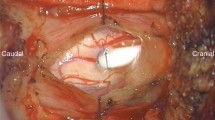Abstract
Objective
Syringoperitoneal shunt is an established method of treating syringomyelia. Syringeal end of the shunt is usually inserted to the patient in prone position, and the peritoneal end is inserted in supine position. This necessitates intraoperative repositioning of patient. To avoid this inconvenience, a new technique of placing the peritoneal end through posterior approach is described in this paper.
Methods and materials
In the new technique, peritoneal cavity is approached through posterior route lateral to erector spinae at the level of L3–L4. An infant who presented with sacral meningocele, tethered cord, and syringomyelia was treated using this new technique along with excision of meningocele and de-tethering of the cord.
Results
There were no complications, and the short-term results at 3-year follow-up are encouraging. Theoretical advantages of the new technique include reduced risk of shunt migration and improved cosmesis of surgical scar.
Conclusion
Posterior approach of placing the peritoneal end of syringoperitoneal shunt is technically feasible, and it appears to have advantages over the traditional method of anterior approach.




Similar content being viewed by others
References
Farmer JP, Bertrand G (2006) Syringoperitoneal shunting. In: Fessler RG, Sekhar L (eds) Atlas of neurosurgical techniques—spine and peripheral nerves. Thieme Medical Publishers, New York, pp 534–537
Phillips TW, Kindt GW (1981) Syringoperitoneal shunt for syringomyelia: a preliminary report. Surg Neurol 16:462–466
Barbaro NM, Wilson CB, Gutin PH, Edwards MS (1984) Surgical treatment of syringomyelia. Favorable results with syringoperitoneal shunting. J Neurosurg 61:531–538
Kunert P, Janowski M, Zakrzewska A, Marchel A (2009) Syringoperitoneal shunt in the treatment of syringomyelia. Neurol Neurochir Pol 43:258–262
Suzuki M, Davis C, Symon L, Gentili F (1985) Syringoperitoneal shunt for treatment of cord cavitation. J Neurol Neurosurg Psychiatry 48:620–627
Ellis H (2006) Clinical anatomy, 11th edn. Blackwell, Oxford, pp 108–109
Burn SC, Sandeman DR (2001) Syringoperitoneal shunt migration: case illustration. J Neurosurg 94(Suppl 2):335
Sgouros S, Williams B (1995) A critical appraisal of drainage in syringomyelia. J Neurosurg 82:1–10
Shimizu S, Hagiwara H, Hattori S, Nakayama K, Fujii K (2009) Change of position using a transportation board during lumboperitoneal shunting. Neurol Med Chir (Tokyo) 49:175–178
Acknowledgments
The author thankfully acknowledges Mr. S.R. Paaryuma, Medical Illustrator, SRM Medical College for the artwork (Fig. 3).
Conflicts of interest
None.
Source of funding
None.
Author information
Authors and Affiliations
Corresponding author
Rights and permissions
About this article
Cite this article
Raveenthiran, V. A new technique of placing the peritoneal end of syringoperitoneal shunt. Childs Nerv Syst 30, 2119–2121 (2014). https://doi.org/10.1007/s00381-014-2544-y
Received:
Accepted:
Published:
Issue Date:
DOI: https://doi.org/10.1007/s00381-014-2544-y




